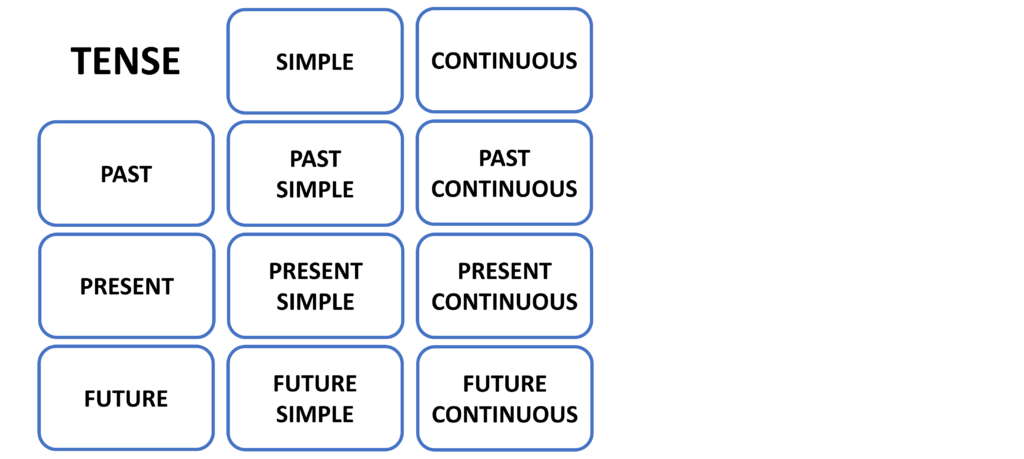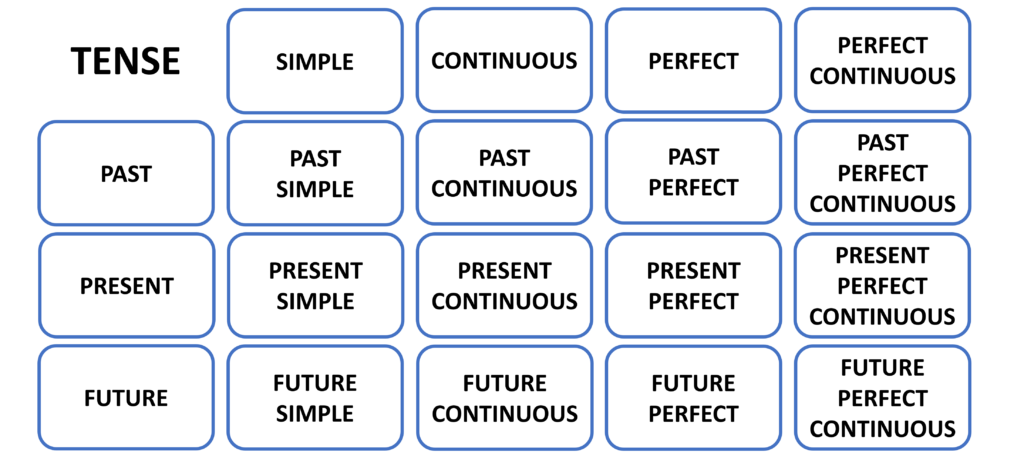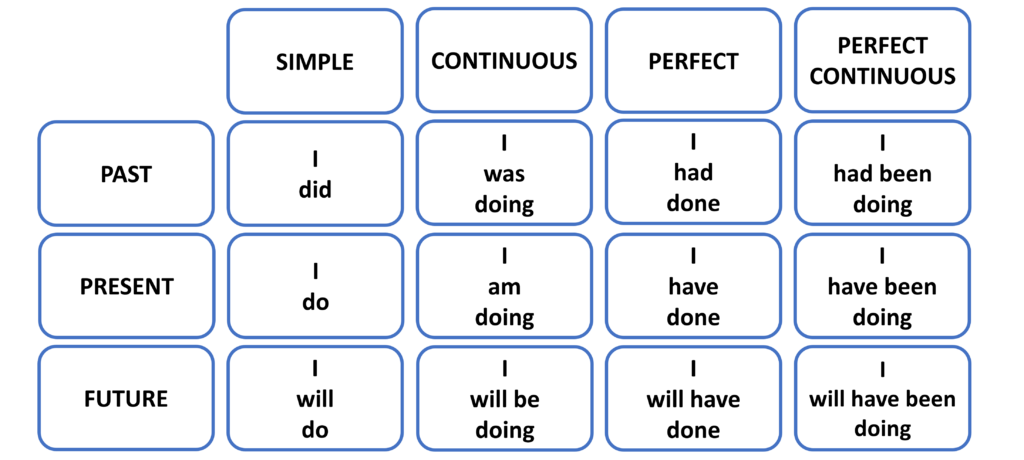Angielskie czasy gramatyczne
English tenses
Ile czasów gramatycznych jest w języku angielskim? Dwanaście? Szesnaście? Niektórzy twierdzą, że jest ich aż dwadzieścia cztery.
How many tenses are there in English grammar? Twelve? Sixteen? Some say there are as many as twenty-four of them.
W tym wpisie postanowiłem rozprawić się z tym tematem.
In this post I decided to deal with this topic.
Dowiesz się, ile angielskich czasów faktycznie jest.
You will find out how many tenses there actually are.
Dowiesz się, jak są zorganizowane i jakie są między nimi relacje.
You will learn how they are organized and how they relate to one another.
I co najważniejsze, pokażę Ci coś, co pozwoli Ci łatwiej je zrozumieć, przyswoić i potem używać.
And most importantly, I will share with you something that will make it easier for you to understand, grasp and then use them.
Czas to czas? Niekoniecznie. Time kontra tense
Time is time? Not necessarily. Time versus tense
Na początek samo słowo czas. Bo czas to time, ale nie w gramatyce. W gramatyce czas to tense, dlatego jeśli po angielsku mówisz o czasach gramatycznych używaj zawsze słowa tense.
First, the word czas itself. Because czas is time, but not in grammar. In grammar, czas is tense, so when you talk about tenses in English grammar, always use the term tense.
Czas (gramatyczny)
Jak zorganizowane są angielskie czasy gramatyczne?
How are English tenses organized?
Matryca, którą za chwilę zobaczysz i którą opiszę bardzo dobrze ilustruje, w jaki sposób powstają i jak zorganizowane są angielskie czasy gramatyczne.
The matrix which you are about to see and which I will describe illustrates very well how English tenses are formed and organized.
Matryca ta ma dwa wymiary.
This matrix has two dimensions.
Pierwszy z nich to odniesienie do czasu rzeczywistego, fizycznego, w którym mamy przeszłość, teraźniejszość i przyszłość.
Dlatego pierwszy wymiar angielskich czasów dotyczy właśnie tych okresów. To dlatego mamy czasy: past, present i future.
The first dimension is the reference to real, physical time, in which we have the past, the present and the future.
Therefore, the first dimension of English tenses refers to these time frames. This is why we have past, present and future tenses.
Ten element czasu gramatycznego wskazuje kiedy coś się dzieje.
This element of a tense indicates when something happens.

Drugi wymiar matrycy to tryb (po angielsku aspect). To z kolei wskazówka jak lub w jaki sposób coś, co opisujesz w zdaniu się dzieje.
The second dimension of the matrix is the aspect. This, in turn, is a clue as to how or in what way something you describe in the sentence happens.
Pierwszy z trybów angielskich czasów to simple, czyli, jak sama nazwa wskazuje, tryb prosty.
The first of the English tense aspects is simple.

I zwróć teraz uwagę, jak tworzą się czasy gramatyczne.
Notice now how grammatical tenses are formed.
Po prostu łączysz czas, w którym coś się dzieje (past, present lub future) z trybem, w jaki sposób to się dzieje.
You simply connect the when (the time in which something happens: past, present or future) with the how (the way it happens).
W ten sposób powstają czasy: past simple, present simple i future simple.
This is how the following tenses are formed: past simple, present simple and future simple.

W tym wpisie nie będę wchodził w szczegóły, w jakich sytuacjach który czas używać. Dziś chodzi o strukturę czasów i relacje między nimi. To pozwoli Ci lepiej je zrozumieć i później łatwiej ich używać.
In this post, I will not go into details on when to use which tense. Today it is about the structure of tenses and the relations among them. It will let you understand them better and make it easier to use them later.
Co się dzieje dalej?
What happens next?
Drugim trybem czasu (czyli sposobem w jaki rzeczy mogą się dziać) jest tryb continuous, czyli tryb ciągły.
The second tense aspect (the way how things can happen) is continuous.

I podobnie, drugi zestaw czasów powstaje poprzez połączenie składowych kiedy i jak (w jaki sposób) coś się dzieje. Formuła pozostaje tutaj bez zmian.
Similarly, the second set of tenses is created by combining the components of when and how something happens. The formula remains unchanged here.
W tym przypadku powstają czasy past continuous, present continuous i future continuous.
In this case, past continuous, present continuous and future continuous tenses are formed.

Trzeci zestaw czasów działa w trybie perfect. Analogicznie, mamy tutaj czasy past perfect, present pefect i future perfect.
The third set of tenses has the perfect aspect. Again, we have past perfect, present perfect and future perfect tenses here.

Uwaga!!! Jeżeli coś dzieje się raz, może to być przypadek. Jeśli coś dzieje się dwa razy, prawdopodobnie wydarzy się trzeci raz.
Ale jeśli coś dzieje się trzeci raz, masz do czynienia z powtarzalnym wzorem. I tak jest w tym przypadku.
Note!!! If something happens once, it may be a coincidence. If something happens twice, it will probably happen a third time.
But if something actually happens a third time, you are dealing with a recurrent pattern. And so it is in this case.
Ostatni tryb angielskich czasów to pefect continuous, który, jak sama nazwa wskazuje (co też jest przydatną podpowiedzią w zrozumieniu sposobu tworzenia czasów), jest połączeniem trybów perfect i continous.
The last aspect of the English tenses is perfect continuous, which, as the name suggests (which is also a useful hint in understanding how to create tenses), is a combination of the perfect and continuous aspects.
Mamy zatem czasy past perfect continous, present perfect continuous i future perfect continuous.
So, we have past perfect continous, present perfect continuous and future perfect continuous tenses.

W ten sposób powstała pełna matryca angielskich czasów gramatycznych.
This way we have just created a complete matrix of English tenses.
Wiesz już, jak powstają i wiesz, ile finalnie ich jest. Jest ich dwanaście.
You know now how the tenses are created and how many of them there are. There are twelve of them altogether.
Jak łatwiej zrozumieć i przyswoić angielskie czasy gramatyczne?
How to make it easier to learn English tenses?
Na koniec obiecana podpowiedź, jak angielskie czasy łatwiej zrozumieć i przyswoić.
Finally, the promised hint on how English tenses can become easier to understand and use.
Ich struktura i relacje, które widzisz w matrycy powyżej to pierwsza część tej wskazówki.
Their structure and relations among them that you see in the matrix above are the first part of this idea.
Druga część podpowiedzi związana jest ze zdaniami, które widzisz poniżej.
Its second part is related to the sentences you see below.

Matryca jest ta sama, tyle, że zamiast nazw czasów, widzisz w niej zdania użyte w określonym czasie.
The matrix remains the same, but instead of the tense names, you see relevant sample sentences.
Chodzi o to, abyś ponownie zwrócił uwagę na powtarzające się wzorce. Na przykład:
The point here is to bring your attention to the recurring patterns. For example:
- wszystkie czasy przyszłe (future) zawierają słowo posiłkowe will;
- wszystkie czasy perfect używają słowa posiłkowego have (w odpowiedniej formie);
- we wszystkich czasach continuos widzisz z kolei czasownik z końcówką -ing.
- all future tenses contain the auxiliary verb will;
- all perfect tenses use the auxiliary verb have (in the correct form);
- in all continuos tenses there is a verb ending in -ing.
Ucząc się języka – zwłaszcza gramatyki – szukaj pewnych wzorów i schematów. Ich zauważenie i analiza pozwoli Ci łatwiej zrozumieć, na przykład, zasady tworzenia zdań i użycia czasów.
Learning a language – especially grammar – look for certain patterns. Seeing and analyzing them will make it easier for you to understand, for example, the rules for creating sentences and using tenses.
A po drugiej stronie ułatwi Ci budowanie zdań, gdy będziesz chciał ich użyć.
And on the other side, it will make it easier for you to build sentences when you want to use them.
Bo język to schematy. Jeśli je znasz, potrafisz zrozumieć to, co ktoś do Ciebie mówi lub pisze. I potrafisz też wyrazić to, na czym Ci zależy.
Languages are made of patterns. If you know them, you can understand what someone says or writes to you. And you are also able to express what you have in mind.
Z tą myślą Cię zostawię.
I will leave you with this thought.
Dobrego angielskiego 😊
Marcin
Możesz też obejrzeć powiązane z tym wpisem wideo.
You can also watch the video related to this post.
![Klucz do angielskich czasów gramatycznych [infografika]](https://angielski.amrc.pl/wp-content/uploads/2023/09/padlock-150506_1280-1-150x150.png)

